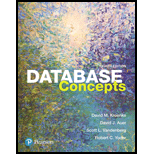
Database Concepts (8th Edition)
8th Edition
ISBN: 9780134601533
Author: David M. Kroenke, David J. Auer, Scott L. Vandenberg, Robert C. Yoder
Publisher: PEARSON
expand_more
expand_more
format_list_bulleted
Concept explainers
Question
Chapter 7, Problem 7.46RQ
Program Plan Intro
XML:
XML stands for “Extensible Markup Language”, provides independent tool for describing data.
- XML data is also referred as self-describing, which means the structure of the data is fixed with the data. Therefore, no need to pre-build the structure of the data when it arrives to store in the
database . - It is a markup language like HTML, contains a set of rules to format the documents that can be read by both humans and machines.
- It is an open standard to create formatted documents and share the structured data using internet or corporate networks.
Expert Solution & Answer
Want to see the full answer?
Check out a sample textbook solution
Students have asked these similar questions
Please answer the question correctly please. Thank you!!
Please answer the question correctly please. Thank you!!
Please answer the question correctly please. Thank you!!
Chapter 7 Solutions
Database Concepts (8th Edition)
Ch. 7 - Prob. 7.1RQCh. 7 - Prob. 7.2RQCh. 7 - Prob. 7.3RQCh. 7 - Prob. 7.4RQCh. 7 - Prob. 7.5RQCh. 7 - Prob. 7.6RQCh. 7 - Prob. 7.7RQCh. 7 - Prob. 7.8RQCh. 7 - Prob. 7.9RQCh. 7 - Prob. 7.10RQ
Ch. 7 - Prob. 7.11RQCh. 7 - Prob. 7.12RQCh. 7 - Prob. 7.13RQCh. 7 - Prob. 7.14RQCh. 7 - Prob. 7.15RQCh. 7 - Prob. 7.16RQCh. 7 - Prob. 7.17RQCh. 7 - Prob. 7.18RQCh. 7 - Prob. 7.19RQCh. 7 - Prob. 7.20RQCh. 7 - Prob. 7.21RQCh. 7 - Prob. 7.22RQCh. 7 - Prob. 7.23RQCh. 7 - Prob. 7.24RQCh. 7 - Prob. 7.25RQCh. 7 - Prob. 7.26RQCh. 7 - Prob. 7.27RQCh. 7 - Prob. 7.28RQCh. 7 - Prob. 7.29RQCh. 7 - Prob. 7.30RQCh. 7 - Prob. 7.31RQCh. 7 - Prob. 7.32RQCh. 7 - Prob. 7.33RQCh. 7 - Prob. 7.34RQCh. 7 - Prob. 7.35RQCh. 7 - Prob. 7.36RQCh. 7 - Show a snippet of PHP code for creating a...Ch. 7 - Show a snippet of PHP code for displaying the...Ch. 7 - Show a snippet of PHP code for disconnecting from...Ch. 7 - Prob. 7.40RQCh. 7 - Prob. 7.41RQCh. 7 - Prob. 7.42RQCh. 7 - Prob. 7.43RQCh. 7 - Prob. 7.44RQCh. 7 - Prob. 7.45RQCh. 7 - Prob. 7.46RQCh. 7 - Prob. 7.47RQCh. 7 - What is the purpose of the FOR XML expression in...Ch. 7 - Prob. 7.49RQCh. 7 - Prob. 7.50RQ
Knowledge Booster
Learn more about
Need a deep-dive on the concept behind this application? Look no further. Learn more about this topic, computer-science and related others by exploring similar questions and additional content below.Similar questions
- Considering the TM example of binary sum ( see attached)do the step-by-step of execution for the binary numbers 1101 and 11. Feel free to use the Formal Language Editor Tool to execute it; Write it down the current state of the tape (including the head position) and indicate the current state of the TM at each step.arrow_forwardI need help on inculding additonal code where I can can do the opposite code of MatLab, where the function of t that I enter becomes the result of F(t), in other words, turning the time-domain f(t) into the frequency-domain function F(s):arrow_forwardI need help with the TM computation step-by-step execution for the binary numbers 1101 and 11. Formal Language Editor Tool can be used to execute it; Write it down the current state of the tape (including the head position) and indicate the current state of the TM at each step;arrow_forward
arrow_back_ios
SEE MORE QUESTIONS
arrow_forward_ios
Recommended textbooks for you
 New Perspectives on HTML5, CSS3, and JavaScriptComputer ScienceISBN:9781305503922Author:Patrick M. CareyPublisher:Cengage Learning
New Perspectives on HTML5, CSS3, and JavaScriptComputer ScienceISBN:9781305503922Author:Patrick M. CareyPublisher:Cengage Learning Principles of Information Systems (MindTap Course...Computer ScienceISBN:9781305971776Author:Ralph Stair, George ReynoldsPublisher:Cengage Learning
Principles of Information Systems (MindTap Course...Computer ScienceISBN:9781305971776Author:Ralph Stair, George ReynoldsPublisher:Cengage Learning
 C++ Programming: From Problem Analysis to Program...Computer ScienceISBN:9781337102087Author:D. S. MalikPublisher:Cengage Learning
C++ Programming: From Problem Analysis to Program...Computer ScienceISBN:9781337102087Author:D. S. MalikPublisher:Cengage Learning Systems ArchitectureComputer ScienceISBN:9781305080195Author:Stephen D. BurdPublisher:Cengage Learning
Systems ArchitectureComputer ScienceISBN:9781305080195Author:Stephen D. BurdPublisher:Cengage Learning

New Perspectives on HTML5, CSS3, and JavaScript
Computer Science
ISBN:9781305503922
Author:Patrick M. Carey
Publisher:Cengage Learning

Principles of Information Systems (MindTap Course...
Computer Science
ISBN:9781305971776
Author:Ralph Stair, George Reynolds
Publisher:Cengage Learning



C++ Programming: From Problem Analysis to Program...
Computer Science
ISBN:9781337102087
Author:D. S. Malik
Publisher:Cengage Learning

Systems Architecture
Computer Science
ISBN:9781305080195
Author:Stephen D. Burd
Publisher:Cengage Learning